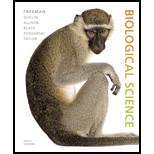
Concept explainers
To review:
The working of the given approach for testing the hypothesis in the given experiment.
Introduction:
A micro ribonucleic acid (miRNA) is a small fragment of RNA, which is derived from the transcription of genes. This fragment of RNA can interfere in the expression of mRNA by binding with its complementary base sequence in an mRNA (messenger RNA). This bond can either lead to the destruction of the mRNA or block translation.
A scientist proposes testing the hypothesis that Kitl is significant to coat coloration. To do this, the scientist plans to observe the outcome when an engineered double-stranded microRNA precursor is expressed in mouse embryos. One strand of the precursor would be complementary to Kitl mRNA.
In the given experiment, the Kitl gene (mouse equivalent of KITLG gene) and its core promoter were bonded together by genetic engineering. The amount of Kitl mRNA was measured in the skin after its introduction in the embryo of a mouse. The results are shown in the graph provided below.

Want to see the full answer?
Check out a sample textbook solution
Chapter 19 Solutions
Biological Science (6th Edition)
- You are trying to produce a mammalian protein in the bacterium Escherichia coli. To make sure you achieve the goal, what should be taken into consideration when you design the experiment (think about the requirements of transcription and translationarrow_forwardBriefly describe two of the tree functions of RNA polymerasearrow_forwardDraw/Diagram and describe RNA processing in eukaryotes. Where does this take place? description should be 1-2 sentences.arrow_forward
- Describe 2 ways RNA is processed after transcriptionarrow_forwardou now have an understanding of Genomes, DNA Replication, Transcription, Translation, and Regulation of Genes. How would you reprogram skin cells to create cells which look and behave like brain cells (neurons)? What would you change/modify to reprogram a skin cell to a neuron? How would you introduce the change/modification into the skin cells to transform them into neurons?arrow_forwardBiology Suppose your friend claims there is a human enhancer at position 1,030,302 of chromosome 1. You run a Hi-C assay on retinal cells, and find no evidence of any physical interactions between that candidate enhancer and any other location in the genome. Can you safely conclude the enhancer does not exist?arrow_forward
- Give typing answer with explanation and conclusion to all parts What would happen to the overall process of making proteins (transcription-translation) if the pores in the nuclear envelope were blocked? Q10. Suppose that an mRNA transcript consists of the following sequence of bases: AUGCCAGGUUAUGUCUAG. a. What sequence of amino acids would this translate to? b. Now suppose that a mutation takes place in the DNA so that twelfth base changes from U to G. How does this change the meaning of the 4th amino acid? (I.e., what does it change to?) c. Would the result be a normal protein? EXPLAIN SPECIFICALLY WHY OR WHY NOT.arrow_forwardmRNA Comparison A scientist studies the production of a key digestive enzyme in silk moths. The moths have one gene for this enzyme, and the scientist extracts mRNA transcribed from this gene as well as protein translated from it. The gene has three introns in its sequence. Use the passage to answer the question. Part A: If the researcher compares mRNA from inside the nucleus to mRNA from the ribosomes, what will be found? A. less mRNA in the nucleus B. shorter mRNA in the ribosomes C. identical mRNAs in both places D. mRNA covalently attached to protein in the nucleus Part B: Use the passage to answer the question. If the same scientist extracts the DNA for this gene and finds that it becomes methylated over the life of the organism, how will digestion change over time? A. It will occur at lower pH. B. It will rely more on this enzyme over time. C. It will use methylated copies of the enzyme. D. It will involve a lesser quantity of this enzyme over time.arrow_forwardAntibiotics are drugs that selectively kill bacteria without harming animals. Many antibiotics act by selectivelybinding to certain proteins that are critical for bacterialfunction. Explain why some of the most successful antibiotics target bacterial RNA polymerase.arrow_forward
- Design an experiment to determine whether a specific gene is transcribed by RNA polymerase II.arrow_forwardIs mRNA +sense, –sense, or a mixture of the 2? What about DNA? Which best describes the template strand used by cellular RNA polymerase?arrow_forwardJustify why RISC attaches to a certain mRNA. What form of bonding takes place?arrow_forward
 Biology (MindTap Course List)BiologyISBN:9781337392938Author:Eldra Solomon, Charles Martin, Diana W. Martin, Linda R. BergPublisher:Cengage Learning
Biology (MindTap Course List)BiologyISBN:9781337392938Author:Eldra Solomon, Charles Martin, Diana W. Martin, Linda R. BergPublisher:Cengage Learning
